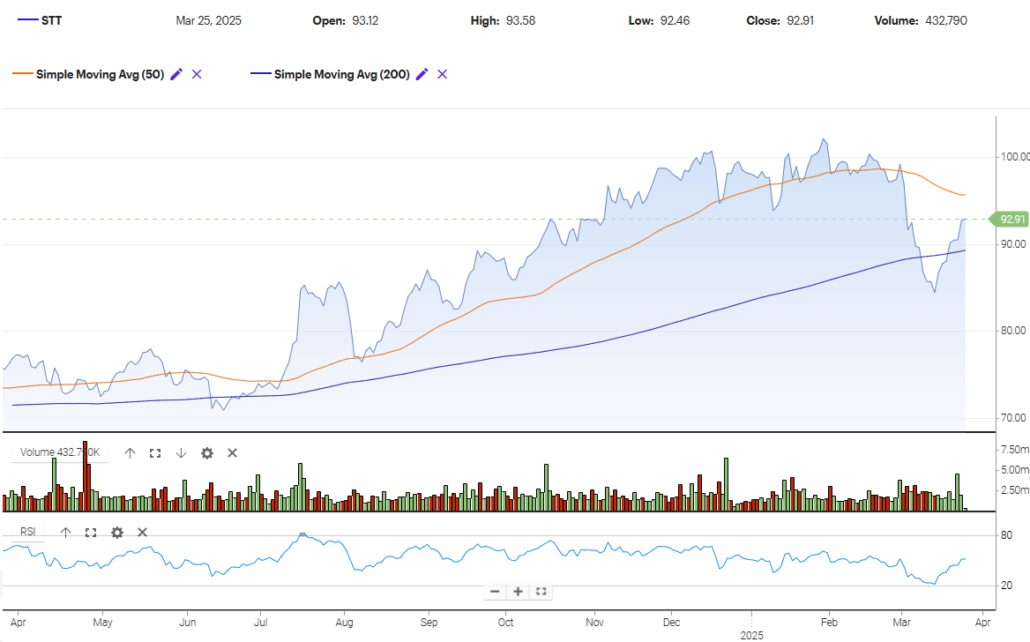Updated 3/26
State Street Corporation’s influence runs deep in the financial world. This Boston-based financial giant plays a critical role behind the scenes, offering investment servicing, management, and research to some of the world’s biggest institutions. With over $41 trillion in assets under custody and administration, it’s one of the foundational firms in global finance.
What makes it especially appealing to dividend-focused investors is its consistency, scale, and conservative approach to capital returns. This isn’t a company chasing fast growth—it’s built to endure.
Recent Events
The most recent earnings update painted a pretty strong picture. State Street posted impressive year-over-year growth, with earnings per share jumping nearly 273%. That kind of surge doesn’t happen often in this space and reflects both improving market conditions and the company’s operational discipline.
Revenue came in at $12.92 billion, up more than 12% from the previous year. That strength flowed through to the bottom line, even as markets have remained choppy. Investors have responded, pushing the stock up nearly 20% over the past year—a solid outperformance compared to the broader index.
With momentum returning and client activity rebounding, State Street is reasserting its role as a steady, income-generating workhorse in a changing market.
Key Dividend Metrics
💰 Forward Dividend Yield: 3.28%
🔁 5-Year Average Dividend Yield: 3.11%
💵 Annual Dividend Rate: $3.04 per share
📈 Payout Ratio: 35.3%
📅 Next Ex-Dividend Date: April 1, 2025
🎉 Next Dividend Pay Date: April 11, 2025
Dividend Overview
At a time when yields are under pressure or inflated by risk, a 3.28% yield backed by decades of financial strength carries real weight. State Street’s dividend is supported by stable earnings, a deep client base, and a steady hand from management.
It’s not trying to wow anyone with massive increases or flashy announcements. Instead, it delivers consistent, measured growth that keeps investors comfortably collecting without worrying about sustainability.
The most recent declared dividend of $0.76 per share continues the upward trend. This isn’t a new practice—State Street has a long history of returning capital to shareholders while maintaining strong fundamentals.
Dividend Growth and Safety
What really stands out here is the security of the dividend. With a payout ratio just over 35%, there’s plenty of room for flexibility even if earnings dip. And when you pair that with high-quality earnings—driven by sticky, recurring revenue from servicing and management fees—it’s a combination built for stability.
There’s a mountain of liquidity on the balance sheet, with over $134 billion in cash. That’s more than double the company’s total debt, giving it cushion to manage through almost any market condition. Cash flow volatility is part of the territory in custody banking, but the underlying profits are solid.
Safety isn’t just about numbers. It’s also about predictability. State Street doesn’t take unnecessary risks, and it hasn’t wavered in its commitment to paying a reliable dividend—even during uncertain times.
Chart Analysis

Current Market Cycle Stage
Looking at the overall shape and flow of this STT chart, the stock appears to be in a reaccumulation phase following a short markdown. After a steady markup from June through early January, price action became more erratic, showing signs of topping behavior—followed by a sharp decline through February and March. However, this pullback has bounced right at the 200-day moving average, which has acted as a dynamic support.
We’re now seeing early signs of strength returning, potentially marking the beginning of a new minor markup within a broader consolidation or reaccumulation zone. This is not distribution—volume didn’t explode on the way down, and price respected long-term support.
Moving Averages and Price Behavior
The 50-day moving average recently turned downward and sits above the current price, which usually reflects short-term bearish pressure. But the rebound from the 200-day moving average (which is still sloping upward) tells a more bullish story from a medium-term lens.
This bounce from around $87 back to nearly $93 has brought price right back to the underside of the 50-day moving average. It’s testing resistance now. If price can reclaim and hold above it in the coming sessions, that could signal the beginning of a new upward leg.
Volume Insights
Volume tells a subtle but important story here. During the March drop, volume didn’t spike massively, which implies there wasn’t a full-blown rush for the exits. On the rebound, volume has started to pick up again—especially on green days. That’s often a quiet sign of accumulation by institutions or patient buyers stepping back in as the stock becomes attractively priced.
No blowout volume yet, but we are seeing slightly elevated activity compared to the flat weeks in January, which supports the idea of reaccumulation rather than panic-driven selling.
RSI Momentum
The RSI bottomed out around 20 in early March, a level that typically reflects deeply oversold conditions. Since then, it’s been climbing steadily and is now approaching the 50 level. That shift in momentum suggests sellers are losing control and buyers are starting to take charge again.
It hasn’t yet crossed into bullish territory, but the slope is constructive. If RSI can break above 50 and hold, that would further support the idea that this is a recovery swing, not just a dead-cat bounce.
Recent Candlestick Action
The last five candles show a consistent upward drive with relatively small upper wicks and stronger closes. This indicates that buyers are pushing the price higher into the close each day, with little rejection from sellers. These are the kinds of candles you typically see when demand is building quietly after a period of fear.
There’s been no aggressive reversal or topping wick to suggest exhaustion. Instead, we’re seeing a controlled climb with increasing strength. This kind of structure tends to lead to continued follow-through—at least toward testing the highs from late February.
The most recent candle closed at $92.91, right beneath the recent resistance zone. If tomorrow opens strong and clears this range with volume, it could confirm a short-term trend reversal.
Analyst Ratings
📈 State Street Corporation (STT) has recently drawn mixed reactions from analysts, reflecting both optimism about its stability and caution around its near-term challenges.
🟢 On March 6, 2025, Morgan Stanley lowered its price target slightly to $139 from $142 but kept an “Overweight” rating. While the target was trimmed, the message was still clear: they see STT outperforming its sector over time, especially as institutional activity stabilizes and markets recover from recent volatility.
🔄 Earlier this year, on January 27, Wolfe Research upgraded the stock from “Underperform” to “Peer Perform.” That’s essentially a shift from expecting STT to lag behind the pack to seeing it move more in line with its peers. The upgrade seemed to be based on improved sentiment around the company’s core business, and perhaps some valuation support after the earlier dip.
🟡 On the flip side, Deutsche Bank made a minor tweak to its target on January 21, reducing it to $103 from $104 while maintaining a “Hold” rating. That suggests they don’t see a major catalyst to push the stock much higher in the short term, but they also don’t see a reason to bet against it.
🎯 As of now, the average price target across 15 analysts sits around $101.87. Targets span a wide range—from $73 on the low end to $139 at the top—which speaks to some differing views on where margins, rate impacts, and fee income might land this year.
📝 The consensus rating is a “Hold,” reflecting a general wait-and-see attitude. With shares recently hovering around $92, there’s still room between current levels and the average target, but the market seems to be digesting mixed signals from both fundamentals and macro factors.
Earning Report Summary
Strong Finish to the Year
State Street wrapped up 2024 on a strong note, showing solid progress across most areas of the business. In the fourth quarter, earnings came in at $2.46 per share, which was a big jump from the $0.55 they posted during the same time last year. That’s not a small leap—it speaks to how much stronger their business has become over the past year.
Total revenue for the quarter reached $3.41 billion, with fee revenue making up the bulk at $2.66 billion, up 13% year-over-year. Net interest income wasn’t far behind, rising 10% to $749 million. Those gains were spread out nicely, coming from both core servicing and asset management lines.
Full-Year Highlights
Zooming out to the full year, State Street delivered $8.21 in earnings per share, a solid increase from $5.58 in 2023. Annual revenue hit $13 billion, which was nearly 9% higher than the previous year. Fee revenue continued to be a steady performer, growing 7% across the year, and net interest income saw record levels—no small feat in this rate environment.
What stands out is that they didn’t just grow earnings on paper. The business actually expanded where it counts. Assets under custody and administration grew to $46.6 trillion, and their assets under management climbed to $4.7 trillion. That’s a reflection of ongoing demand for their services, and the trust institutions continue to place in them.
State Street wasn’t shy about sharing the success. Over the course of 2024, they returned $2.2 billion to shareholders. That came through a mix of share repurchases and a 10% increase to the quarterly dividend. For long-term investors, that kind of return is what makes the stock more than just a steady performer—it becomes a reliable income play.
Overall Take
The story from this earnings report is pretty straightforward: State Street is managing its core business well, delivering stronger earnings, and rewarding shareholders along the way. The numbers showed clear improvement from last year, and management seems focused on maintaining that momentum heading into 2025.
Financial Health and Stability
The balance sheet tells a confident story. With $58.5 billion in total debt and more than twice that in cash reserves, State Street is in no danger of being overextended. That strength gives the company the ability to invest, return capital, or simply weather storms without flinching.
Profitability also stands out. Net profit margins hover around 20%, and operating margins are close to 30%. These are solid levels for any financial company, especially one in the custodial and asset servicing space. Return on equity is nearly 11%, showing efficient use of shareholder capital without stretching too far.
With a book value per share around $78 and the stock trading in the low $90s, the valuation is grounded in fundamentals rather than hype. Price to book at 1.19 isn’t overly demanding, and when you consider the business quality, it looks reasonable.
Valuation and Stock Performance
Valuation here feels pretty grounded. The trailing P/E is just over 11, while forward estimates come in closer to 9.6. That’s a fair price for a company that generates consistent profits and pays out a steady, growing dividend.
The PEG ratio sits under 1, suggesting that investors aren’t overpaying for the level of growth they’re getting. And with a 52-week range between $70 and $103, the current price near $92 still leaves a bit of upside if sentiment improves further.
It’s also worth pointing out that the company has been more resilient than the market might expect. Volatility is part of the story here, especially with a beta of 1.47, but the business itself doesn’t operate on drama—it operates on reliability.
Risks and Considerations
Like any financial stock, State Street has its set of risks. The most notable one is interest rate exposure. When rates are high, State Street benefits from wider spreads on cash balances. But when rates begin to fall, that tailwind could turn into a slight headwind.
The operating cash flow was notably negative last year, which might look concerning at first glance. But for a company handling huge flows of institutional money, cash flow numbers can swing based on client behavior. The core business remains profitable, which is the more important signal.
There’s also ongoing regulatory oversight. As a systemically important financial institution, State Street is subject to layers of global and domestic rules that can affect its flexibility or cost structure. It’s the price of playing such a central role in the financial system.
Lastly, the high level of institutional ownership means trading can be influenced by fund flows more than retail sentiment. But the relatively low short interest suggests that most investors are holding for stability, not volatility.
Final Thoughts
State Street doesn’t need to make bold moves or chase market trends. Its value lies in its ability to do the unglamorous work—accurately, reliably, and at scale. For income investors, that’s a strength, not a flaw.
The dividend is strong, the business is essential, and the valuation is grounded in real fundamentals. While it may never be the flashiest stock in your portfolio, State Street has all the qualities that dividend investors tend to appreciate: stability, consistency, and a quiet ability to deliver year after year.

